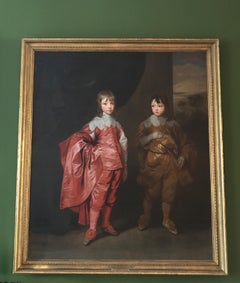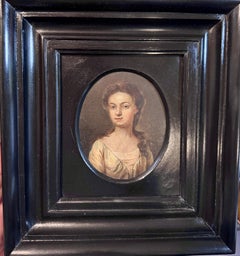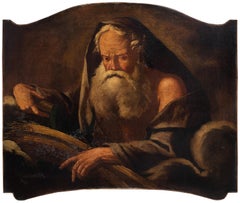(After) Anthony Van Dyck Figurative Paintings
Dutch, 1599-1641
Sir Anthony van Dyck (22 March 1599 – 9 December 1641) was a Flemish Baroque artist who became the leading court painter for Charles I of England. Sir Anthony Van Dyck was born in the Netherlands and painted from an early age becoming a successful independent painter in his late teens, and a master in the Antwerp Guild in 1618. He painted in the studio of Peter Paul Rubens who became a major influence on his work. Van Dyck worked in London for some months in 1621, then returned to Flanders and travelled to Italy, where he stayed until 1627, mostly in Genoa. He spent five years in Flanders after his return from Italy, and was court painter for the archduchess Isabella, Habsburg Governor of Flanders. In 1632 he returned to London to become the main court painter to Charles I of England.
After Holbein, van Dyck and his contemporary Diego Valezquez were the first painters of pre-eminent to work mainly as court portraitists, revolutionising the genre. Van Dyck is best known for his portraits of the royals and aristocracy, most notably Charles I, and his family and associates. Van Dyck widely influenced English portrait painting for the next 150 years. His portrait style changed considerably between the different countries he worked in, culminating in the relaxed elegance of his last English period. His influence extends into the modern period. During his lifetime, Charles I granted him a knighthood, and after his death Van Dyck was buried in St Paul’s Cathedral, an indication of his high standing at the time of his death.to
1
1
Overall Width
to
Overall Height
to
1
1
1
1
1
3
462
330
261
214
1
1
Artist: (After) Anthony Van Dyck
Double Portrait Oil Painting Brothers George, 2nd Duke Buckingham & Lord Francis
By (After) Anthony Van Dyck
Located in London, GB
Aftrer Anthony VAN DYCK - maybe Studio (1599, Antwerp – 1641, London) Flemish
Double Portrait of George Villiers, 2nd Duke of Buckingham (1628-1687) & Lord Francis Villiers (1629-1648)
Oil on Canvas
170 x 147 cm
Anthony Van Dyck (1599-1641)
No painter has done more to define an era than Anthony van Dyck. He spent only seven and a half years of his short life (1599- 1641) in England. He grew up in Antwerp, where his precocious talent was recognised by Peter Paul Rubens, the greatest painter of his age. He worked in Rubens’s studio and imitated his style as a religious artist, painting biblical scenes redolent of the lush piety of the counter-reformation. But soon he was on the move. In 1620, he visited London for a few months, long enough to paint a history picture, The Continence of Scipio, for the royal favourite, George Villiers, Marquess of Buckingham, and a portrait of his other English patron, the great art collector, Thomas Howard, 2nd Earl of Arundel.
After a stint in Italy, making imposing portraits of the wealthy aristocracy and sketching and copying works by Titian, he returned to the Spanish Netherlands in 1627, becoming court artist to Archduchess Isabella before departing for The Hague in 1631 to paint the Dutch ruler Frederick Henry, Prince of Orange. Charles I’s invitation in 1632 led Van Dyck back to London where he was knighted, paid an annual salary of £200 and installed in a house in Blackfriars with a special jetty at which the royal barge might tie up when the King was visiting his studio. By this time Van Dyck was recognised as the leading court painter in Europe, with Velazquez at the court of Philip IV of Spain his only rival. He also excelled as a superbly observant painter of children and dogs.
Van Dyck’s notoriety in depicting children led to the introduction of groups of children without their parents as a new genre into English painting (amongst other new genres).
For the next 300 years, Van Dyck was the major influence on English portraiture. Nearly all the great 18th Century portraitists, from Pompeo Batoni and Allan Ramsay to Thomas Gainsborough and Joshua Reynolds, copied Van Dyck’s costumes, poses and compositions.
George Duke of Buckingham & his brother Francis Villiers
Painted in 1635, this double portrait was originally commissioned by Charles I, who raised the two brothers after their father, George Villiers, was assassinated in 1628. Together with their sister, Lady Mary Villiers, they enjoyed the King’s favour absolutely. Francis whose absolute ‘inimitable handsomeness’ was noted by Marvell (who was killed in a skirmish near Kingston upon Thames). The young duke who commanded a regiment of horse at the Battle of Worcester, remained closely associated with Charles II, held a number of high offices after the Restoration and was one of the most cynical and brilliant members of the King’s entourage, immortalised as ‘Zimri’ in Dryden’s Absalom and Achitopbel. As a young man he had sold his father’s great collection of pictures in the Spanish Netherlands, many of them to the Archduke Leopold Willhelm.
Painted for Charles I and placed near the portrait of their sister in the Gallery at St James’ Palace. The handling of both costumes is very rich, and the heads are very carefully and sensitively worked. That of the younger boy in particular is more solidly built up than the lower part of the figure. A preparatory drawing for the younger boy is in the British Museum.
There are copies at, e.g., Highclere Castle...
Category
17th Century Old Masters (After) Anthony Van Dyck Figurative Paintings
Materials
Oil
Related Items
Oval 18th century Portrait of a Young girl, oil on copper
By (Follower of) Sir Godfrey Kneller
Located in Woodbury, CT
This exquisite 18th-century portrait depicts a young girl, delicately rendered in the style of Sir Godfrey Kneller, one of the most celebrated portrait painters of the Baroque period...
Category
1750s Old Masters (After) Anthony Van Dyck Figurative Paintings
Materials
Copper
Antique Italian painter - 18th century figure painting
Located in Varmo, IT
Italian painter (18th century) - Chrono.
90.5 x 106 cm.
Antique oil painting on canvas, without frame (not signed).
Condition report: Lined canvas. Good state of conservation of t...
Category
Early 18th Century Old Masters (After) Anthony Van Dyck Figurative Paintings
Materials
Canvas, Oil
$4,728 Sale Price
20% Off
H 35.63 in W 41.74 in
A Portrait of a Bewigged Gentleman
By Enoch Seeman
Located in St. Albans, GB
Enoch Seeman
Canvas Size: 30 x 25" (76 x 62cm)
Outside Frame Size: 37 x 32" (92 x 80cm)
1694-1744
He was born in Danzig, now Gdansk, Poland, around 1694. His father, also Enoch...
Category
Early 18th Century Old Masters (After) Anthony Van Dyck Figurative Paintings
Materials
Oil
Portrait of a Man – A Dramatic Study in Light and Expression
Located in Stockholm, SE
This compelling portrait, recently studied by Stéphane Pinta of the esteemed Cabinet Turquin in Paris, has been confidently attributed to the Austrian painter Matthäus (Matthias) Lod...
Category
Late 18th Century Old Masters (After) Anthony Van Dyck Figurative Paintings
Materials
Canvas, Oil
$8,251
H 27.17 in W 23.23 in
Set of Five late 19th century Italian or French portraits of Putti or Angels
Located in Woodbury, CT
Set of Five late 19th century Italian or French portraits of Putti or Angels
A unique set of five oils on board depicting either Cherubs or Putti, ...
Category
1890s Old Masters (After) Anthony Van Dyck Figurative Paintings
Materials
Oil, Board
$3,900 Sale Price
40% Off
H 9 in W 9 in
18th century oil painting English portrait of a gent in armor, wearing a wig
By studio of Sir Godfrey Kneller
Located in Woodbury, CT
Outstanding early 18th century English portrait of James Bellevue.
The portrait was always believed to be the work of Sir Godfrey Kneller who was known to have painted James Bellevu...
Category
Early 1700s Old Masters (After) Anthony Van Dyck Figurative Paintings
Materials
Canvas, Oil
$7,960 Sale Price
20% Off
H 38 in W 33 in
18th century French Old Master Portrait of a woman in oriental costume
Located in Aartselaar, BE
French 18th century old master portrait of a majestic lady dressed "à la Turque"
The sitter at the viewer with a kind and enigmatic smile and twinkling eyes. She looks elegant and kind, yet also has an intelligent and determined aura, reflecting the character of someone who is in charge of her own life and destiny.
De Silvestre paid great attention to her spectacular outfit, which is striking in its portrayal of the sumptuous fabrics and their decorative richness. She is wearing a luxurious royal blue robe à la...
Category
1740s Old Masters (After) Anthony Van Dyck Figurative Paintings
Materials
Canvas, Oil
$22,124
H 31.89 in W 25.6 in D 0.4 in
Early Historical Portrait Believed to be of Scottish Politician David Carnegie
By John Baptist De Medina
Located in Houston, TX
Early historical portrait in the style of William Aikman believed to be of David Carnegie, 4th Earl of Northesk, a Scottish peer and politician. The work features the central figure ...
Category
Early 1700s Old Masters (After) Anthony Van Dyck Figurative Paintings
Materials
Canvas, Oil
$7,500
H 55.25 in W 46 in D 1.5 in
19th century English Portrait of a Young boy in a Cavalier costume
Located in Woodbury, CT
This elegant English 19th-century portrait of a young boy dressed in a Cavalier costume, painted circa 1860, is a striking example of Victorian portraiture that seamlessly combines h...
Category
1860s Old Masters (After) Anthony Van Dyck Figurative Paintings
Materials
Canvas, Oil
18th century Portrait of a young girl, Miss Cator in a landscape, white dress
By John Russell
Located in Woodbury, CT
Portrait of a young British Girl, in her white dress with Pink Sash.
Choosing to acquire an 18th-century portrait of a young girl by English artist John Russell is an opportunity to...
Category
1780s Old Masters (After) Anthony Van Dyck Figurative Paintings
Materials
Canvas, Oil
$7,960 Sale Price
20% Off
H 21 in W 18 in
!8th century Irish or English portrait of a woman with Ermin, blue dressing lace
Located in Woodbury, CT
Wonderful 18th century Irish or English portrait, attributed to the Irish painter Nathaniel Hone.
Nathaniel Hone was born in Dublin but by 1748 had set...
Category
1780s Old Masters (After) Anthony Van Dyck Figurative Paintings
Materials
Oil
$9,200 Sale Price
20% Off
H 31 in W 27 in
Madonna with Holy Child and St. John
Located in Fredericksburg, VA
Madonna with Holy Child and St. John is a masterful depiction of a tender religious scene, capturing the sacred relationship between the Virgin Mary, the infant Jesus, and St. John t...
Category
17th Century Old Masters (After) Anthony Van Dyck Figurative Paintings
Materials
Wood, Oil
(after) Anthony Van Dyck figurative paintings for sale on 1stDibs.
Find a wide variety of authentic (After) Anthony Van Dyck figurative paintings available for sale on 1stDibs.
Questions About (After) Anthony Van Dyck Figurative Paintings
- 1stDibs ExpertOctober 30, 2024How much a van Dyck painting is worth varies based on its historical significance, condition and size. At a London auction in 2009, a self-portrait of the artist sold for $13.5 million. Sir Anthony van Dyck was a Flemish Baroque artist who became the leading court painter for Charles I of England. He is best known for his portraits of royalty and aristocracy, most notably Charles I and his family and associates. His style changed considerably between the countries he worked in, culminating in the relaxed elegance of his last English period. Van Dyck widely influenced English portrait painting for the next 150 years, and his influence extended into the modern period. If you own a van Dyck piece, use the services of a certified appraiser or knowledgeable art dealer to learn how much it may be worth. On 1stDibs, find a variety of Baroque art.


